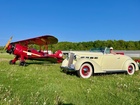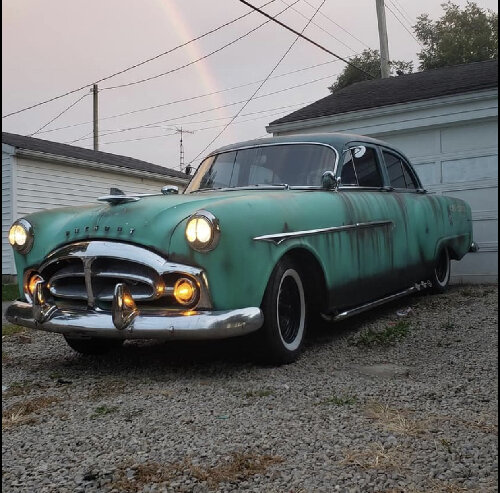|
Re: High Speed Rear End for 1941 Packard 110 club coupe?
|
||||
|---|---|---|---|---|
|
Home away from home
|
Is your car a 115 six, a 120 eight, or one of the "senior" cars?
What size tires are you using?
Posted on: 2023/4/23 21:25
|
|||
|
||||
|
Re: 1956 Packard 400 Front End Rebuild
|
||||
|---|---|---|---|---|
|
Home away from home
|
I would NOT start taking things apart without determining exactly what is wrong. Any steering box adjustments should be made with a service manual at hand. Also, be sure that correct replacement parts are available for any replacements that may be necessary.
Most all steering systems will have play at the steering wheel unless the front wheels are pointed straight ahead. Check play on a power steering system with the engine running and the front wheels straight ahead. May cars have a flexible coupling in the steering shaft. These couplings often develop play. Most steering shaft couplings are located between the firewall and the steering box.
Posted on: 2023/4/23 6:50
|
|||
|
||||
|
Re: interior door handle removal...,mystery
|
||||
|---|---|---|---|---|
|
Home away from home
|
At one time, auto parts stores carried such tools. CalVan was one maker, as I recall. Most auto parts stores still carry a variety of specialty tools. The hidden clip style door and window handles were widely used. Some cars had a square shaft with a pin to hold the handle in place. The pin was retained by the escutcheon trim, which could be pushed in toward the door to allow removing the pin.
Posted on: 2023/4/23 6:41
|
|||
|
||||
|
Re: When I hit the pedal it cuts the power on my 1949 22 series
|
||||
|---|---|---|---|---|
|
Home away from home
|
When driving in overdrive, flooring the accellerator causes the overdrive kickdown switch to momentarily disable the ignition system to allow the overdrive unit to shift into direct drive with the throttle open. ("Passing gear")
If the switch or the related linkage sticks, or if the switch has an internal short, or if the related wiring has a short, the ignition system will not function and the car will not start. If the linkage is out of adjustment or sticking, it can cause the kickdown switch to disable the ignition when the accellerator pedal is depressed to start the car. Cleaning up the linkage may help. You might also try, when starting the car, pressing down the accelerator pedal just far enough to engage the starter switch. Pressing the pedal down too hard may engage the kickdown switch, which will prevent the engine from starting. A car that is started by pressing down the accellerator will have some means of automatically disabling the starter function once the engine is running to prevent the starter from engaging with the engine running. I suggest having a service manual on hand before attempting to adjust the linkage or making any wiring changes. It's important that both the starting and the overdrive kickdown functions work properly, and it's very important that the starter not be engaged when flooring the accellerator with the engine running. Read the owner's manual to be sure you are using the correct starting procedure.
Posted on: 2023/4/23 6:31
|
|||
|
||||
|
Re: When I hit the pedal it cuts the power on my 1949 22 series
|
||||
|---|---|---|---|---|
|
Home away from home
|
Driving a car daily is not an issue as long as maintenence is done properly and completely. Personally, I would not drive an old car in rain on a regular basis, and I would never want to expose it to the cursed road salt.
However, driving any car just two miles a day is severe service. A car needs to run for ten miles or so in cooler weather just to warm up and re-charge the battery from starting. If you only drive two miles a day on any regular basis, or two trips of two miles a day, such as a two mile commute to work, you need to drive the car for ten miles or more at least a couple of times a week to prevent condensation and sludge in the crankcase, a chronically undercharged battery, and perhaps fouled spark plugs. I suggest that you drive the car for 10 miles or more at least a couple of times a week, whether by taking the long way around to work, or just taking a half hour or longer pleasure drive. Longer is better. In cold weather, a car needs to run for a period of time, at least half an hour, in order to have time to fully warm up the engine, recharge the battery, and get the engine and the engine oil hot enough, for long enough, to drive off normal moisture and fuel condensation from the crankcase. An engine will make about 3 gallons of water for every gallon of gasoline that it burns, and some of it will find its way into the crankcase, where it will do harm. This is in addition to any naturally-occuring condensation. Starting the car and then letting it idle to "warm up" is a very bad practice. It's best to start the car, let it run for about 30 to 45 seconds, then put it in gear and drive away, avoiding high speeds or or hard pulls for a few miles. Condensation can also form in rear axles and transmissions, and driving the car for 10 miles or more will tend to bring all these units up to operating temperature and drive off any moisture, as well as assuring that seals are fully lubricated. A two mile a day regimen in cold weather is brutal on a car. Under such service conditions, the oil ought to be changed every 1,000 miles.
Posted on: 2023/4/22 9:51
|
|||
|
||||
|
Re: Ken's 1937 120 Touring Sedan
|
||||
|---|---|---|---|---|
|
Home away from home
|
If your car has a tapered hub and key arrangement at the rear wheel hubs, be sure both rear hubs are absolutely tight on the axle shafts and that all mating parts are in good condition and the keys and keyways are a tight fit.
Posted on: 2023/4/20 15:28
|
|||
|
||||
|
Re: 1938 Super 8 1605 - adventures with a newbie
|
||||
|---|---|---|---|---|
|
Home away from home
|
Another thought:
To measure maximum vacuum the fuel pump can develop, I'm pretty sure you would need to have the discharge side open to the atmosphere. Otherwise the diaphragm will load up and move very little.
Posted on: 2023/4/19 19:36
|
|||
|
||||
|
Re: 1938 Super 8 1605 - adventures with a newbie
|
||||
|---|---|---|---|---|
|
Home away from home
|
If it's 7" of mercury that should be adequate. However, I think it should hold vacuum for at least a while in the suction side if everything is absolutely tight, just as it would normally hold some pressure on the discharge side assuming the carb bowl is full and everything is tight.
Posted on: 2023/4/19 19:26
|
|||
|
||||
|
Re: Ken's 1937 120 Touring Sedan
|
||||
|---|---|---|---|---|
|
Home away from home
|
Even slight looseness of the U-bolts that hold the axle to the springs could cause a clunk on takeoff.
Stopping the car with the brakes makes the axle try to roll with the wheels, which would take up any slight looseness and allow the axle to move to the limit of any small amount of travel the u bolt looseness would permit. It would not have to be much, and the u-bolts would not need to be sloppy loose to allow the slight movement, since the forces involved are significant. Friction would probably keep the axle at the forward rotated position until you put the car in gear and began to release the clutch to move forward. This action makes the axle houing attempt to rotate backward, which could cause the axle to slip back to its normal position, or a little beyond, making a thump or clunk sound. Even a very small movement could cause the noise. The cure would be to clean everything up and torque the u- bolt nuts to spec, taking care to pull them up evenly. Make sure that all related parts are not bent or worn, and that the u-bolt nuts aren't bottoming out before they are actually holding the axle and hardware securely. Some cars had rubber or leather pads between the spring pads on the axle housing and the springs. If those are flattened, rotted or missing, they may have to be replaced for the hardware to tighten properly and hold the axle housing correctly. Be sure the shock bodies are tightly bolted to the frame, too. If one is a little loose, it could cause a clunk.
Posted on: 2023/4/19 18:37
|
|||
|
||||








